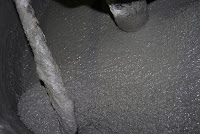 A real UHPC (Ultra High Performance Concrete)
A real UHPC (Ultra High Performance Concrete) consists of a maximum of three components:
- UHPC binder
- Water
- Aggregates, such as quartz sand with a grain size of 0-3 mm
Nothing else is necessary. No further additives.
UHPC concrete of exceptional quality is an
easy-to-manufacture material, provided you have
the right high quality components. For more than
25 years our UHPC Mortar, UHPC Cast, and
UHPC Shotcrete have been mixed by specialists
and amateurs around the world.
 Let's start with the most important thing, the mixer.
Let's start with the most important thing, the mixer.We need a compulsory, pan-pot or shaft mixer for
small to medium UHPC concrete volumes.
For larger UHPC concrete quantities, the use of
continuous mixer is recommended.
If you are not sure whether your mixer is suitable
for processing please contact us, we will be happy
to help you.
1st operation
Mix UHPC binders and aggregates, such as quartz
sand, in a proportion of one bag of binder (25 kg)
and one bag of quartz sand (25 kg) dry for
approx. 3 minutes.

2nd operation
Add water, add approx. 3.8 liters per 25 kg UHPC
binder and mix for at least 7 minutes.
3rd operation
Install the material. For the installation by a average
ambient temperature of 18° - 25° you have about
45 minutes time.
4th operation
Seal the newly laid surface with a suitable wax liquid
such as UHPC curing compound or a suitable foil.
That's it.
All our UHPC materials are mixed in this way. If you
have mixed one UHPC material quality, you can mix
all other UHPC material qualities as well.
 Simple and easy.
Simple and easy.We also provide a detailed Mixing and processing
manual for UHPC Cast, UHPC Mortar and UHPC
Shotcrete, with many practical tips
You can order this manual at the following e-mail address
service@hhbc-consulting.de and password "UHPC mixing and application manual."
UHPC technology mixing and applying UHPC under normal
conditions and under extreme conditions.
www.hhbc-consulting.de
info@hhbc-consulting.de





















